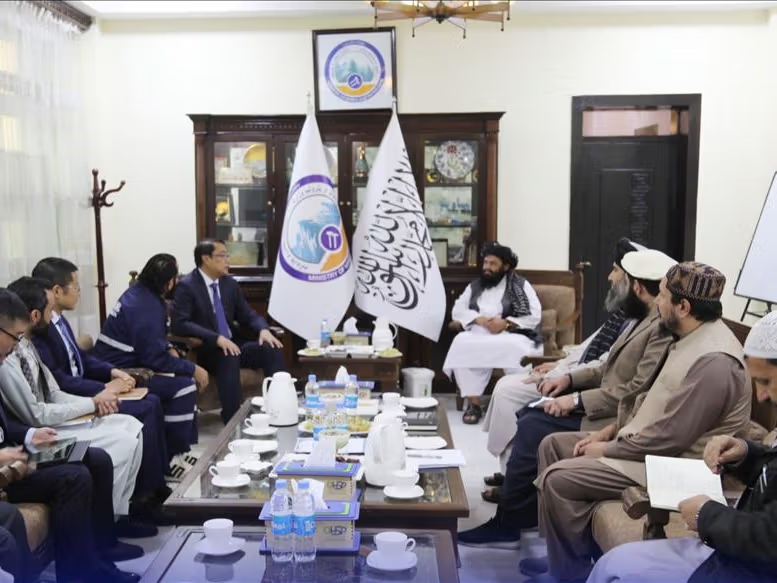RASC News Agency: Mawlawi Hedayatullah Badri, the Taliban regime’s acting Minister of Mines and Petroleum, has urged Chinese contractors to expedite operations at the long-delayed Mes Aynak copper mine in Logar Province, describing the project as “strategically indispensable” to the Taliban’s struggling economy.
In a statement issued by the Ministry of Mines, Badri met in Kabul with senior representatives of the Metallurgical Corporation of China (MCC-T) and MJAM, the joint venture responsible for the project. According to the Taliban, the Chinese delegation reaffirmed its “unwavering commitment” to executing all contractual obligations and had already begun preparatory work to provide electricity to the site.
The Mes Aynak project, launched nearly two decades ago, was once hailed as the crown jewel of Afghanistan’s post-war economic reconstruction.
In 2008, the former Afghan government signed a 30-year extraction deal with MCC, which offered $2.9 billion in investment and pledged a further $5 billion to build essential infrastructure including a 400-megawatt power plant, a rail link, and paved access roads.
Located in Logar Province’s Mohammad Agha District, the mine is believed to contain copper reserves valued at over $50 billion, ranking among the world’s most lucrative untapped deposits. Yet the project languished for years, stalled by persistent insecurity, political volatility, and corruption.
Even with a special protection force established under the previous government, the Chinese consortium repeatedly cited deteriorating security as a reason to suspend operations.
Since their return to power in August 2021, the Taliban have inherited both the mine and the burden of unmet expectations.
In 2024, the Ministry of Mines claimed that all “outstanding disputes” with MCC-T had been resolved, allowing work to resume. However, the regime has disclosed no details of any revised agreements raising suspicions that new terms may heavily favor Beijing.
Analysts say the Taliban’s renewed urgency stems less from strategic foresight than from financial desperation.
Cut off from the global banking system, unable to access more than $7 billion in frozen reserves, and shunned by Western donors, the regime has turned to resource extraction as a survival mechanism.
By offering generous concessions to Chinese firms, the Taliban hope to secure foreign currency inflows and project an illusion of international legitimacy even as the country’s economy teeters on collapse.
“This is not an investment strategy it’s economic triage,” said a Kabul-based economist now living in exile. “The Taliban are mortgaging Afghanistan’s natural wealth for short-term political survival.”
Beijing, for its part, has maintained a cautiously pragmatic engagement with the Taliban regime. While China has not officially recognized the Taliban as Afghanistan’s legitimate government, it has become one of their few consistent interlocutors, pursuing what experts describe as “commercial diplomacy under the shield of geopolitical opportunism.”
Mes Aynak, situated roughly 40 kilometers southeast of Kabul, fits squarely within China’s broader push to secure access to critical minerals vital for its energy transition and manufacturing sectors.
Yet despite Beijing’s rhetoric of partnership, progress remains minimal. Environmental and archaeological concerns have further slowed implementation the site sits atop a sprawling Buddhist archaeological complex, one of Central Asia’s most significant cultural heritages, now at imminent risk of destruction under open-pit mining.
“The Taliban see copper; the world sees history,” noted a cultural preservation expert formerly associated with UNESCO. “This project could erase two thousand years of civilization for the sake of political optics.”
Critics argue that the Taliban’s handling of the Mes Aynak negotiations highlights their chronic lack of transparency, administrative competence, and public accountability.
Since returning to power, the regime has dismantled oversight institutions, silenced independent media, and centralized economic decision-making under loyal clerics and former insurgent commanders.
No information has been made public regarding revenue-sharing mechanisms, environmental safeguards, or community compensation frameworks.
Afghanistan’s economists warn that, under Taliban management, the Mes Aynak deal risks becoming a patronage pipeline, enriching a narrow elite while ordinary citizens remain impoverished.
Local residents have reported land seizures and forced displacements, often without compensation a pattern reminiscent of the Taliban’s broader governance model, in which control outweighs development.
A previous meeting between Mullah Abdul Ghani Baradar, the Taliban’s deputy prime minister for economic affairs, and Wang Jicheng, MCC’s president, reiterated the same message: “begin operations immediately.”
Yet despite repeated promises, there has been no evidence of large-scale extraction or infrastructure development on the ground.
For the Taliban, Mes Aynak is more than an economic project it is a political instrument, a tool to showcase engagement with a major power and mask the reality of growing international isolation.
For Beijing, Afghanistan offers resources without reform, access without accountability, and a regime willing to trade sovereignty for survival.
More than seventeen years after its inception, the Mes Aynak mine remains a barren landscape of rusting machinery and unfulfilled ambition a monument not to progress, but to the enduring collision between exploitation and fragility under Taliban rule.






